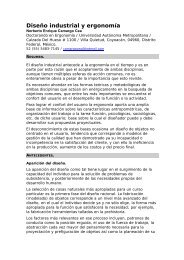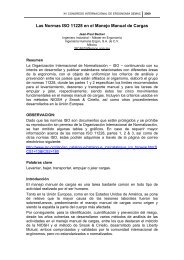ERGONOMÍA OCUPACIONAL - SOCIEDAD DE ERGONOMISTAS ...
ERGONOMÍA OCUPACIONAL - SOCIEDAD DE ERGONOMISTAS ...
ERGONOMÍA OCUPACIONAL - SOCIEDAD DE ERGONOMISTAS ...
Create successful ePaper yourself
Turn your PDF publications into a flip-book with our unique Google optimized e-Paper software.
Ergonomía Ocupacional. Investigaciones y Aplicaciones. Vol 3 2010<br />
2.2. Experimental Design Application: Third Stage – Assignment.<br />
It is known that the most usual criterion to select the experimental design is the reduction of the<br />
variance of the regression coefficients. The key element to select a design that diminishes the<br />
variance is the orthogonality concept used by Taguchi in experimental designs. In fact, the<br />
complete factorial designs of two levels and the fractions of resolution III are orthogonal.<br />
In the ergonomic experimentation is possible to separate main effects and interactions using<br />
either of the following methods: (1) assign the main effect to the points to the linear graph<br />
assuming that interactions between three factors does not exist; (2) use a special orthogonal array<br />
where interactions confound equally with every level of the main effects. The first method uses the<br />
columns corresponding to the points on the linear graph en orthogonal arrays L 8 , L16,<br />
L32,<br />
L9<br />
and L 27 . For the second method L 12, L18<br />
and 36<br />
L orthogonal arrays are used which are of practical<br />
use in the industry for their effectiveness and reduction of costs (Wu, 1992).<br />
If we cannot anticipate possible interactions between factors, we can obtain quite a lot of<br />
information from past experience. But, if we cannot anticipate interactions, we can take any of the<br />
following approaches: (1) Assign the interaction between two factors. (2) Use orthogonal arrays<br />
12 , L18<br />
L or 36<br />
assign factors.<br />
L that does not generate interaction information. (3)Ignore interactions when you<br />
For experiments in ergonomics it is of interest principally to know the principal effects of factors,<br />
from what the second option is most recommended since it uses three levels and does not need<br />
to stop in the study of interactions that might be subjective in this stage of the process although<br />
the ability to anticipate is a part of technological know-how (G.Taguchi, 1986). For this reason the<br />
Taguchi methods for the case of study have been programmed in spreadsheets because these<br />
allow flexibility of programming for this type of algorithms. In fact, it contains statistical tools.<br />
Sociedad de Ergonomistas de México, A.C. 81




